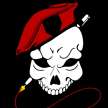Who Was The Real Captain Morgan?
A Nasty Cocktail in His Own Right

Captain Morgan is a name known far and wide, but today the only fear it generates is in people who can't quite remember what they did after their eighth shot of rum on Saturday night. However, unlike some products that come up with catchy names and memorable mascots to go with them, Captain Morgan was a real person. Beyond simply existing though, Captain Henry Morgan wrote his name in gunpowder and blood all throughout the Caribbean in the 1600s.
Also, while we're on the subject of pirates, Was Captain Jack Sparrow a Real Person? No, but you might be surprised that several historical pirates did go into his design.
For more articles on pirates, history, and general curiosity, don't forget to check out my full Vocal archive!
Early Life
No one really had birth certificates in the 1600s; in fact it was considered an achievement to get both the mother and the baby through the ordeal. As such there's no concrete evidence of when, precisely, Henry Morgan was born. That said, the best guess currently available according to Thought Co is that the future captain kicked and howled his way into our world in the year 1635 in Wales, probably at Llanrhymny or Abergavenny. These are real places, and a map of Wales says so.
Henry's father was a squire, a man by the name of Robert Morgan. Whether his father was constantly running around and trying to help men into armor history doesn't say, but one can guess that life in Wales in the 17th century was exactly as exciting as it sounds. That would explain why Henry decided to get the hell out of the old country in a big, big hurry, joining the Venables-Penn Expedition in 1654.
The Privateer's Life

While the original expedition that brought Henry to the New World went belly up faster than a six year old's fair goldfish, with the failed invasion of Hispaniola and the subsequent business in Jamaica Morgan found that he rather liked the Caribbean. Whether it was the sunshine, the surf, or the profusion of men flying the Jolly Roger remains unclear, but he chose to stay in Jamaica rather than return to Wales. While there was plenty of work in shipyards, docks, and in other relatively safe professions, Henry had gotten a taste for action. So he mustered a crew, and became a privateer; a fairly common choice for men who wanted to thrills of piracy without the worry of being hanged for such activities by their own government. This was roughly in 1662, according to The Way of The Pirates.
The main reason the English crown had started licensing mercenaries in the Caribbean was simple economics. Spain was one of England's biggest competitors in the empire game, and they had a toehold in the New World. That meant spices, lumber, gold, crops, and a plethora of resources were flowing into Spain's coffers via the shipping lanes. And while they were powerful, the English Navy couldn't be everywhere at once. So the monarchy gave letters of writ to private captains, giving them free rein to attack enemy ships in England's name, and to claim the ship and the cargo for queen, country, and a fat cut of the proceeds. Lots of men leaped at the chance to bloody Spain and steal its riches, but Captain Henry Morgan was one of the most brutal, and successful, privateers since Sir Francis Drake.
Captain Morgan's seagoing career was full of the stuff coastal nightmares are made of. For instance, his first official raid was in 1664, and every victory poured money into his coffers, and grew his reputation. Morgan started drawing men and ships to him, until he'd arranged a force of 500 or so able-bodied men. Rather than just tool around the Caribbean, though, he decided to take his new friends and sack the town of Portobello. His men looted the town six ways from Sunday, and then ransomed it for 100,000 pesos on threat of burning the whole thing to the ground. Then they sauntered off, ships riding low with plunder and the sheer weight of their testicular fortitude.
Henry sat on that for a year or so, but his itch needed to be scratched and in 1668 he decided that it was time to go another round with Spain. It took until early 1669 to get all the men, ships and plans together, but when he had assembled his A-team Morgan sailed into Lake Maracaibo. They smashed the fort defending the lake, and blew through the towns of Maracaibo and Gibraltar, and loaded up like it was free food day at the pirate booty buffet. In fact, they were so busy sacking and pillaging that Morgan and company didn't notice Spanish warships blockading the harbor mouth, or the cannons that were brought up to re-arm the fort. Putting on his troll face, Henry sent a fire ship against the Spanish blockade. When all was said and done he sunk one ship, captured a second, and forced the third to be abandoned. He also managed to trick the men manning the guns to point them inland, which allowed he and the rest of his sea-going scoundrels to sail right on back out to sea again.
The least profitable, but most infamous, of his raids was on the gilded city of Panama. Given permission by the governor of Jamaica, Henry got back in the game for one last ride in 1671. He gathered an army of brigands, thugs, and miscellaneous ne'er-do-wells, and once they'd reached 1,000 strong they made their move. They sailed to the island, parked on the rear side, and started an overland march. Word got to the town about the oncoming horde, and the knowledge of who was leading them was enough to send the town's defense force into a panic. The defenders managed to rally at the last moment, but they were quickly overwhelmed by the hard-bitten corsairs who'd come with murder on their minds. While Morgan took the town, much of the treasure had already been moved out. A hollow victory is still a victory, though.
The Aftermath
While the Panama adventure marked the end to the illustrious career of Captain Morgan as a privateer, the issue was that it took place after England and Spain had officially signed a peace treaty. Given that news traveled at roughly a third of the speed of smell, it's entirely possible that Henry didn't know this at the time of the raid. It's just as likely that he knew, but decided he could feign ignorance if ever taken to task. While rich and famous, grown fat on his blood money and exploits, even Captain Morgan wasn't beyond the reach of the crown's justice. When word of what happened in Panama reached the court Henry was summoned... and promptly treated like a superstar when he reached England.
While the governor who sanctioned Panama received a wrist slap and a shaken royal finger, Henry Morgan didn't even get that. He was wined and dined by the rich and famous, asked to tell tales of his exploits, and generally regarded as a figure of great daring and swagger. Afterward he sailed back home to Jamaica with the title of knight, and lived out the rest of his days as a wealthy landowner profiting off the huge stakes he held in the Caribbean.
A fan of too much drink, nights in the inn, and the company of hard partiers, Captain Henry Morgan eventually woke up dead in 1688. He was given a royal send off, complete with the firing of guns, and a funeral fit for a hero. His legacy still lives on, and though he never officially flew the black flag, Morgan was still one of the greatest terrors the high seas has ever seen.
About the Creator
Neal Litherland
Neal Litherland is an author, freelance blogger, and RPG designer. A regular on the Chicago convention circuit, he works in a variety of genres.
Blog: Improved Initiative and The Literary Mercenary






Comments
There are no comments for this story
Be the first to respond and start the conversation.